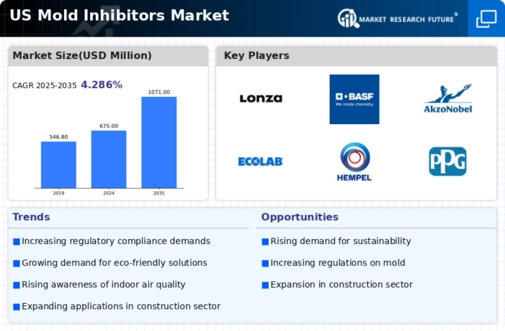Increased Construction Activities
The resurgence of construction activities in the United States is significantly impacting the mold inhibitors market. With the construction sector projected to grow by 5% annually, the demand for mold inhibitors is expected to rise correspondingly. New buildings, particularly in regions with high humidity, require effective mold prevention solutions to ensure structural integrity and occupant health. The mold inhibitors market is adapting to this demand by offering specialized products designed for various construction materials. Additionally, the trend towards sustainable building practices is encouraging the use of eco-friendly mold inhibitors, further driving market growth. As builders and contractors prioritize mold prevention in their projects, the mold inhibitors market is likely to see an influx of innovative solutions tailored to meet these emerging needs.
Rising Awareness of Indoor Air Quality
The increasing awareness regarding indoor air quality is a pivotal driver for the mold inhibitors market. As consumers become more informed about the health risks associated with mold exposure, the demand for effective mold inhibitors is likely to rise. Studies indicate that poor indoor air quality can lead to respiratory issues and other health problems, prompting homeowners and businesses to seek solutions. The mold inhibitors market is witnessing a surge in product development aimed at improving air quality, with a projected growth rate of approximately 6% annually. This trend is particularly pronounced in urban areas, where high humidity levels and inadequate ventilation exacerbate mold growth. Consequently, manufacturers are focusing on creating innovative mold inhibitors that not only prevent mold but also enhance overall indoor air quality, thereby addressing consumer concerns.
Consumer Preference for Eco-Friendly Products
The mold inhibitors market is experiencing a shift driven by consumer preference for eco-friendly products. As environmental concerns gain traction, consumers are increasingly seeking mold inhibitors that are non-toxic and biodegradable. This trend is reflected in market data, which suggests that eco-friendly mold inhibitors could capture up to 30% of the market share by 2027. Manufacturers are responding by reformulating existing products and developing new ones that align with these preferences. The mold inhibitors market is thus witnessing a transformation, with a growing emphasis on sustainability and safety. This shift not only caters to consumer demands but also positions companies favorably in a competitive landscape, as eco-conscious consumers are willing to pay a premium for environmentally friendly solutions.
Regulatory Standards and Compliance Requirements
Regulatory standards and compliance requirements are increasingly influencing the mold inhibitors market. As health and safety regulations become more stringent, manufacturers are compelled to ensure that their products meet specific guidelines. This trend is particularly evident in the construction and building maintenance sectors, where compliance with mold prevention standards is critical. The mold inhibitors market is adapting to these changes by investing in research and development to create compliant products. Additionally, companies that prioritize regulatory adherence are likely to gain a competitive edge, as consumers become more discerning about product safety. The ongoing evolution of regulations may also lead to increased demand for certified mold inhibitors, further propelling market growth.
Technological Innovations in Product Development
Technological innovations are playing a crucial role in shaping the mold inhibitors market. Advances in chemical formulations and application techniques are leading to the development of more effective and longer-lasting mold inhibitors. For instance, the introduction of nanotechnology in product formulations is enhancing the efficacy of mold prevention solutions. The mold inhibitors market is likely to benefit from these innovations, as they provide manufacturers with the tools to create superior products that meet evolving consumer needs. Furthermore, the integration of smart technologies, such as sensors that detect moisture levels, is expected to drive market growth. These innovations not only improve product performance but also offer consumers greater convenience and peace of mind, thereby expanding the market's potential.






















Leave a Comment